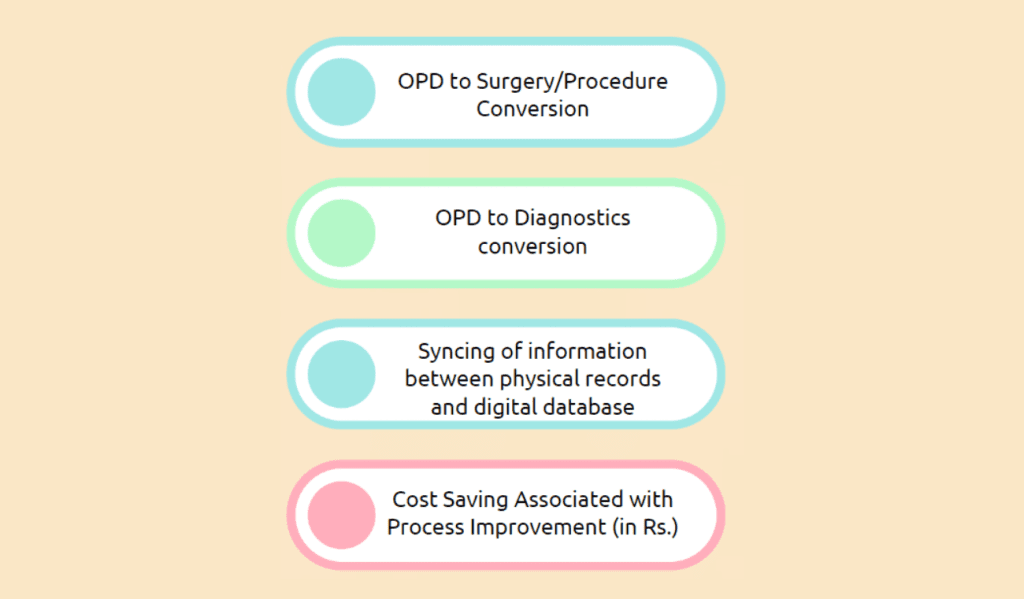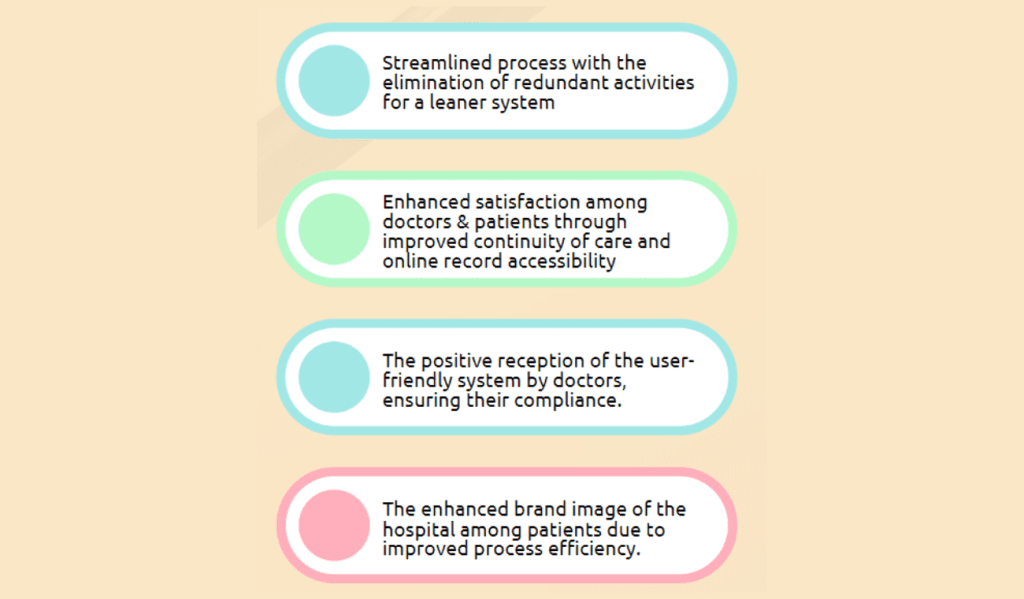Seamless Care through Digital OPD Prescriptions: Enhancing Continuity of Care
Read the Magazine in PDF
Abstract :
This case study focuses on the digitalization of OPD prescription records at Wockhardt Hospitals, Mira Road, to ensure continuity of care and improve operational efficiency. The challenges faced with physical record management and the need for a streamlined process are discussed. The multidisciplinary team implemented various strategies, including transitioning to digital records, tracking conversions, and conducting audits, to enhance care continuity and stakeholder satisfaction. The results demonstrate significant improvements in surgery/procedure conversions, diagnostics conversions, data synchronization, cost savings, and time efficiency.
Organization Profile
Wockhardt Hospitals, Mira Road, is a leading multispeciality hospital with 330 beds. As part of the Wockhardt Hospital Group, our core ideology is “Life Wins.” We are proud to have achieved several milestones, including NABH accreditation, NABL accreditation, Manyata accreditation, and Eat Right Campus certification. Quality and safety are prioritized at all levels of our hospital’s governance model, which includes clinical, shared nursing, and corporate departments.
We regularly conduct specialized training programs such as NIHSS Certification, Stroke Management, Stoma Care, and Pain Nurse Training to ensure continuous professional development. Our hospital offers round-the-clock services, including ambulance, emergency, medical and surgical care, laboratory, radiology, and pharmacy services. With a team of highly experienced and skilled professionals, we provide advanced diagnostic and treatment facilities in a comfortable and nurturing environment.
We are committed to providing comprehensive healthcare solutions to all community segments, including societies, schools, institutions, NGOs, corporate members, and individuals. Our specialized medical services cover cardiology, cardiac surgery, neurology, neurosurgery, orthopaedics, joint replacements, minimal access surgery, gastroenterology, oncology, haematology, mother and child care, urology, nephrology, and transplant services. We strive to meet the diverse healthcare needs of our patients and deliver superior care in all specialties.
Introduction
The outpatient department (OPD) plays a vital role in the overall functioning of the hospital as it serves as the initial point of contact for patients. Its seamless integration with other departments, including IPD, diagnostics, and support departments, is crucial for ensuring continuity of care. However, there have been challenges in maintaining continuity of care due to the reliance on physical OPD records. Issues such as lack of uniformity in documentation, appropriate storage, archival, and timely retrieval have been areas of concern.
Our team acknowledged the impact of the patient’s experience during their OPD visit on overall satisfaction and recognised the need to address these challenges and improve in this area.
Efficient retrieval of information from physical records and establishing a support system for care continuity across diagnostics, IPD, and pharmacy departments have been significant areas of concern. This was done by using the following:
- The conversion numbers from OPD to other prescribed services indicate care continuity and business performance. Therefore, our primary focus has been accurately tracking these conversions to ensure seamless patient care and operational success.
- The multidisciplinary team prioritized care continuity for OPD patients and identified concerns with the current patient record management process in OPD. Tools, techniques, and process mapping were discussed and finalized by the team to address these concerns. Fishbone analysis was used to identify process deficiencies and develop an improvement plan for enhanced operational efficiency.
The team evaluated the advantages and disadvantages of transitioning from physical to digital records, considering gaps in the current structure, associated costs, and feasibility.
Baseline measurements were taken to accurately capture conversions from OPD to other services (surgeries/procedures, investigations, pharmacy), including prescriptions under each sub-head.
The goal was to streamline and improve the efficiency of the OPD record management process with a stakeholder-oriented approach.

The following steps were taken to find the solution to the problem:
- A process map was defined for transitioning to digital OPD records.
- PDCA cycles were used to implement digital OPD records.
- Non-value-added activities were eliminated with digital documents.
- Training, process monitoring, and regular stakeholder discussions were essential for change management.
- Daily audits were conducted to understand gaps and build ownership in the team.
- Resources were tracked to measure cost savings.
- Business conversions were tracked monthly to ensure care continuity and develop a strategy.
The following steps were taken to make sure that the improvement measures were maintained:
- Audit and review plans were implemented to lock the improvements, including daily prescription audits and monthly MIS on conversion.
- Digital prescription using Doxper was phased in, starting with the 2nd floor and then the 1st floor, followed by tracking and follow-up of leads for surgeries, procedures, investigations, and pharmacy.
- Learnings from each phase were replicated and implemented in subsequent phases.
Outcome :


Conclusion
The successful implementation of digital OPD records at Wockhardt Hospitals, Mira Road, has significantly improved care continuity and operational efficiency. The transition from physical documents to digital records eliminated redundant activities, improved data synchronization, and enhanced the satisfaction of both doctors and patients. The implementation process involved thorough planning, continuous training, regular audits, and stakeholder engagement, contributing to successfully adopting the new system. The achieved results, such as increased conversion rates, cost savings, and time efficiency, highlight the positive impact of digitalization on the hospital’s performance. The hospital’s brand image has also been positively influenced, and the streamlined process has fostered a sense of ownership among the staff. Overall, this case study emphasizes the importance of digital transformation in healthcare organizations and its benefits in terms of patient care, stakeholder satisfaction, and operational effectiveness.




